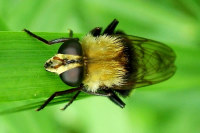Phylum Arthropoda (Arthropods) ➔ Subphylum Hexapoda (Hexapods) ➔ Class Insecta (Insects) ➔ Order Diptera (True flies) ➔ Family Syrphidae (Hoverflies)
Criorhina berberina (Fabricius, 1805)
Synonyms and other combinations:
Criorhina bombiformis Perris, 1839 | Criorhina brebissonii Macquart, 1829 | Criorhina graeca Schirmer, 1913 | Milesia oxyacanthae Meigen, 1822 |
Classification:
Criorhina berberina belongs to the subfamily Eristalinae, tribe Milesiini.Distribution:
Fennoscandia south to the Pyrenees and northen Spain; from Ireland eastwards through central Europe to European parts of Russia and Turkey; Italy; the former Yugoslavia, Romania.Habitat:
Deciduous and coniferous forest with overmature trees and well-developed herb and shrub layers.Description:
Criorhina berberina is an 8 - 13 mm long, very dense hairy hoverfly with a bumblebee-like appearance, which occurs in two different color forms. In the more common form berberina the thorax is yellow hairy and the abdomen is at the base black and at the end whitish yellow hairy. The rarer color form oxyacanthae has a uniform yellow hairiness. Criorhina berberina has reddish-yellow antennae, black legs and thornless, barely thickened femora.Biology:
Criorhina berberina flies from Mai to September. Adults are often seen visiting flowers or resting on sunlit foliage. Females can be found flying around at the base of old living trees, stumps and near dead or dying trees searching for suited places for oviposition. The larvae develop in moist decaying wood of dead tree roots, in cavities of fallen trunks and the heart-rot of living trees. Larvae were found on beech (fagus), ash (Fraxinus) and birch (betula).References, further reading, links:
- Pape T. & Thompson F.C. (eds) (2017). Systema Dipterorum (version 2.0, Jan 2011). In: Species 2000 & ITIS Catalogue of Life, 2017 Annual Checklist (Roskov Y., Abucay L., Orrell T., Nicolson D., Bailly N., Kirk P.M., Bourgoin T., DeWalt R.E., Decock W., De Wever A., Nieukerken E. van, Zarucchi J., Penev L., eds.). Digital resource at www.catalogueoflife.org/annual-checklist/2017. Species 2000: Naturalis, Leiden, the Netherlands. ISSN 2405-884X.
- M.C.D.Speight: Species Accounts of European Syrphidae (Diptera), Glasgow 2011, Syrph the Net, the database of European Syrphidae, vol. 65, 285 pp., Syrph the Net publications, Dublin.
- Gerald Bothe: Bestimmungsschlüssel für die Schwebfliegen (Diptera, Syrphidae) Deutschlands und der Niederlande, DJN, 1984, ISBN 3-923376-07-3
- Menno Reemer, Willem Renema, Wouter van Steenis, Theo Zeegers, Aat Barendregt, John T. Smit, Mark P. van Veen, Jeroen van Steenis, Laurens van der Leij: De Nederlandse Zweefvliegen (Diptera: Syrphidae), Nederlandse Fauna 8, 2009.
- Anasimyia interpuncta
- Anasimyia transfuga
- Baccha elongata
- Blera fallax
- Brachyopa sp.
- Brachypalpoides lentus
- Brachypalpus laphriformis
- Brachypalpus sp.
- Brachypalpus valgus
- Ceriana conopsoides
- Ceriana vespiformis
- Chalcosyrphus femoratus
- Chalcosyrphus nemorum
- Chalcosyrphus valgus
- Cheilosia albipila
- Cheilosia albitarsis
- Cheilosia chrysocoma
- Cheilosia illustrata
- Cheilosia pagana
- Cheilosia scutellata
- Cheilosia sp.
- Cheilosia variabilis
- Chrysogaster sp.
- Chrysotoxum bicinctum
- Chrysotoxum fasciatum
- Chrysotoxum festivum
- Chrysotoxum verralli
- Criorhina berberina
- Dasysyrphus albostriatus
- Dasysyrphus sp.
- Dasysyrphus tricinctus
- Didea fasciata
- Didea intermedia
- Didea sp.
- Epistrophe diaphana
- Epistrophe eligans
- Epistrophe flava
- Epistrophe grossulariae
- Epistrophe melanostoma
- Epistrophe melanostoma/nitidicollis
- Epistrophella euchroma
- Episyrphus balteatus
- Eristalinus aeneus
- Eristalinus megacephalus
- Eristalinus taeniops
- Eristalis arbustorum
- Eristalis interrupta
- Eristalis intricaria
- Eristalis lineata
- Eristalis pertinax
- Eristalis rupium
- Eristalis similis
- Eristalis sp.
- Eristalis tenax
- Eumerus purpurariae
- Eumerus sp.
- Eupeodes corollae
- Eupeodes luniger
- Eupeodes sp.
- Eurimyia lineata
- Ferdinandea cuprea
- Hammerschmidtia ferruginea
- Helophilus hybridus
- Helophilus pendulus
- Helophilus sp.
- Helophilus trivittatus
- Ischiodon aegyptius
- Leucozona glaucia
- Leucozona laternaria
- Leucozona lucorum
- Melangyna lasiophthalma
- Melangyna quadrimaculata
- Melangyna umbellatarum
- Melanogaster sp.
- Melanostoma scalare
- Meligramma triangulifera
- Meliscaeva cinctella
- Merodon ambiguus
- Merodon avidus
- Merodon equestris
- Merodon moenium
- Merodon obscuritarsis
- Merodon sp.
- Microdon analis/major
- Microdon mutabilis/myrmicae
- Myathropa florea
- Myolepta dubia
- Orthonevra sp.
- Paragus sp.
- Parasyrphus lineolus
- Parhelophilus sp.
- Pipiza austriaca
- Pipiza bimaculata
- Pipiza fenestrata
- Pipiza quadrimaculata
- Pipiza sp.
- Platycheirus rosarum
- Platycheirus sp.
- Rhingia campestris
- Rhingia rostrata
- Scaeva albomaculata
- Scaeva pyrastri
- Scaeva selenitica
- Sericomyia lappona
- Sericomyia silentis
- Sphaerophoria rueppelli
- Sphaerophoria scripta
- Sphaerophoria sp.
- Sphegina sp.
- Spilomyia saltuum
- Syritta pipiens
- Syrphus ribesii
- Syrphus sp.
- Syrphus vitripennis
- Temnostoma bombylans
- Temnostoma meridionale
- Temnostoma vespiforme
- Tropidia scita
- Volucella bombylans
- Volucella inanis
- Volucella pellucens
- Volucella zonaria
- Xanthogramma citrofasciatum
- Xanthogramma pedissequum
- Xylota segnis
- Xylota sp.
- Xylota sylvarum

